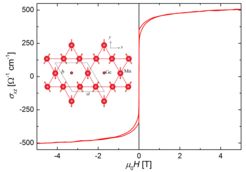Press Release: Anomalous Hall effect in non-collinear antiferromagnets
Resistivity measurements are the standard experiment to distinguish insulators from metals. With a similar set-up – by applying an additional magnetic field – the so-called Hall effect can be measured, which gives us more information beyond the resistance such as the charge carrier concentration and their mobility. The Hall effect in a normal conductor arises due to the Lorentz force acting on the conducting electrons in the presence of a magnetic field. In comparison to normal conductors, ferromagnetic materials exhibit a large spontaneous Hall effect, termed the anomalous Hall effect, which roughly scales with the magnetization. In contrast to ferromagnets, the atomic moments in antiferromagnets cancel each other by pointing in different directions. Therefore, such materials with zero net magnetic moment have been generally believed not to display any anomalous Hall effect.
In a recent study, however, scientists from the Max Planck Institute for Chemical Physics of Solids in Dresden and the Max Planck Institute of Microstructure Physics, Halle, have experimentally demonstrated that the antiferromagnetic compound Mn3Ge displays an extremely large anomalous Hall conductivity. The observed value is even much larger than the anomalous Hall effect observed in many ferromagnetic materials with large net magnetic moment. This fascinating observation was first predicted by theory two years ago and can be explained by the symmetry of the crystal structure and a particular arrangement of the internal magnetic moments. In the present case, the Mn atoms are arranged in a so-called kagome lattice, named after a traditional Japanese woven bamboo pattern (see figure, left inset). Due to the triangular arrangement therein, the Mn atoms, which want to orient their moments in an antiparallel pattern, cannot satisfy this relation. To escape this so-called magnetic frustration, they form non-collinear 120-degree spin triangles in the basal plane of the lattice. In ferromagnets, the origin of the anomalous Hall effect has been described in terms of the Berry-phase curvature, a fictitious magnetic field felt by the conduction electrons. In Mn3Ge, however, the particular non-collinear chiral magnetic structure breaks the symmetry of the crystal structure, leading to this unexpected effect.
Recently, antiferromagnets have attracted immense interest in the spintronics community, and the discovery of the Max Planck scientists can open a new direction for the development of applications: In contrast to ferromagnets, where the external so-called stray fields are detrimental for most applications, antiferromagnets do not produce any external fields. Thus, for the future material development, the demonstration and the understanding of the anomalous Hall effect in Mn3Ge offer a good recipe for the realization of antiferromagnetic spintronics.
AKN ; HR / CPfS

Magnetic field dependence of the anomalous Hall conductivity for Mn3Ge. The inset shows the triangular spin-arrangement of the Mn atoms in the ab-plane.












